In this week’s Sunshine + Microbes, learn the nefarious history behind a renowned ad campaign, listen to some favorite food podcasts, get fizzy with it in our fermentation origin stories series, and herbalist Juliane Miklos teaches us how to make a fun fall infusion.
If you enjoyed this newsletter, please forward it to friends (and give our Facebook and Instagram pages a follow). And if someone shared this newsletter with you, subscribe below.

Climate change isn’t your fault. Even if you exclusively drink bottled water. Even if you eat a hamburger for every meal. Even if you make a long daily commute in a gas guzzler. If you, dear reader, are an oil exec or the CEO of a multinational agricultural conglomerate or a lobbyist for the plastics industry, 1. thanks for reading! And 2. it’s your fault.
In 1971, a famous commercial helped corporations shift the onus of “don’t pollute” from companies to individuals. In an Intercept article about the plastic industry (plus an accompanying doc cited in last week’s newsletter), author Sharon Lerner unpacks the image of Keep America Beautiful’s crying Indian.
The ad spread the message that pollution was the fault of the douchebag throwing his fast food trash out the car window. Sure, that guy is a jerk. But the secret behind the ad is that Keep America Beautiful has long been funded by some extremely eco-unfriendly businesses - PepsiCo, Coca-Cola, Philip Morris, Nestle Waters and McDonald’s to name a few. That one litterbug’s hamburger wrapper is nothing compared to the Coca-Cola corporation’s roughly 3 million tons of plastic packaging annually. The marketing campaign worked as a (very successful) means of blame shifting. Pay no attention to the man behind the greenwashed curtain: It’s your fault!
From The Intercept:
To this day, Keep America Beautiful — which is still led by executives at beverage and plastics companies, including Dr Pepper, Dow, and the American Chemistry Council — continues to focus on litterbugs, prodding errant citizens to better dispose of their plastic waste while many of its members fend off regulation of their production of that waste. Several of the group’s corporate partners — including founding companies Coca-Cola and PepsiCo and their trade group, the American Beverage Association — have opposed bottle bills that have been shown to help solve the plastic waste problem.
Five decades since the “Crying Indian” ad, society still frames the environmental crisis as a matter of personal responsibility instead of the systemic challenge that it is.
Cleaning up this mess is a collective responsibility. The coal baron won’t. Neither will the oil exec. At least, not without massive pressure campaigns waged by the little guys. It’s both heartening and frustrating to see oppressed and disadvantaged groups — who will bear the brunt of climate change even though they are not to blame — leading the fight for environmental justice.
Although I understand that the climate crisis will only be solved through structural changes, I still try to practice climate-friendly habits. I get that eating less meat or riding my bike might not make a difference on a micro-level. But when enough of us change our behavior, I have hope that with our powers combined, a cultural shift can occur: A sea-change that would hold the powerful accountable and transform the political, social, and corporate structures. Don’t let the powers-that-be convince you that climate change is your fault. It’s not. Don’t let them tell you that you can’t make a difference. We can.
love,
Jackie

You Should be Listening to… 🎧
I am a purebred podcast proselytizer. I listen to podcasts all day long in the kitchen. What a fabulous way to learn and engage with ideas. Today I want to spotlight two of my very favorite food podcasts, plus a bonus climate-focused one. Add them to your queue! -Jackie
Hosts Cynthia Graber and Nicola Twilley tell food stories “through the lens of science and history.” Each new episode is the highlight of my fortnight. Try this one, in which Cynthia and Nicola embark on a rigorous personalized nutrition study that may or may not change everything we understand about food and health. Another excellent episode examines how we might grow our food...in space!
Intrepid reporter Tom Philpott helms Mother Jones’ food journalism podcast. The stories connect food with politics, the environment, and culture. Currently they are in the midst of a multi-part series called Eating in Climate Chaos. The most recent episode, In Vino Veritas, is a must-listen for anyone that cares about climate change and/or enjoys drinking alcohol (turns out those are extremely related topics). Another fave is There is No Such Thing as a Free (School) Lunch about the overwhelming social benefit of free school lunches. The episode highlights a case study on a school district leading the way serving healthy, free meals that don’t break the school board piggy bank.
Subscribe to Yale’s Climate Connections for short — each episode is about 2 minutes long — solutions-focused climate change stories. Check out this fascinating episode on how scientists are turning algae into steel (or at least a substance as strong as steel!).
Fermentation Origin Stories
Learn how some of our favorite Florida fermentos got their start. (Pssst, get your tickets to Ferment Fest here!). Nella of Awaken Kombucha explains what first stirred her love of kombucha. Share your own fermentation origin story with us at sunshineandmicrobes@gmail.com.
My journey with kombucha started 11 years ago, when a friend of mine knew I was going through some stomach issues. She brought over a SCOBY (Symbiotic Culture Of Bacteria and Yeast), culture, and a gallon jar and gave me a lesson on kombucha, explaining why she thought it could help me. The creepy looking SCOBY intimidated me, so I left it on my counter and never went back to it. Back then, I noticed GT Kombucha was the only brand available in stores, so I tried a bottle and that’s when things changed. After two weeks of drinking kombucha, I got off a handful of medicine the doctors had prescribed to me.
Fast forward to 2014, when I was pregnant, kombucha soothed the stomach troubles that came with that. After my son was born I approached my friends who ran a kombucha company, and asked them if they would be interested in teaching me how to brew. I apprenticed under them for six months. They taught me how to ferment in oak barrels and I ended up moving to Florida to start my own company. It’s now 2019 and I couldn’t be more grateful for where I am. I create a product that is helping people with some of their stomach ailments and allowing them to find relief through fermentation.
Fresh Links
Our favorite food and environment reads from around the internet. Give’em a click👇
Weekend Dinners Around the World | NY Times
Dig into this gorgeous photo essay that showcases family dinners in 18 different places around the globe. The stomach-stirring images include a Haitian family serving sos pwa nwa (“a black bean sauce served with rice”) with a crab dish, a picture from a Sabbath meal in Israel, and condiments galore (hibiscus green chile sauce! beet and carrot sauerkraut! papaya chutney!) to compliment a chicken dinner for a Nigerian family in Lagos.

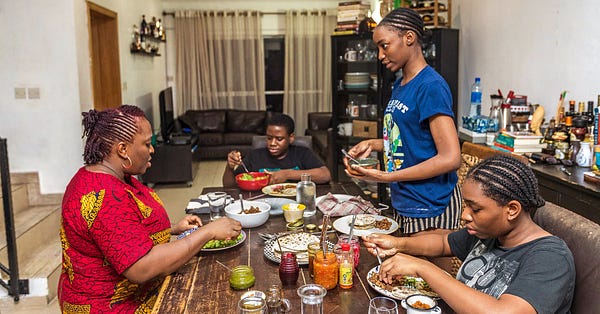
🍺👑An Interview With The Chinese Farmer and Stunt Drinker Who Became Our King | Deadspin
In the spring, a Twitter video from China went viral of a man making extremely unhealthy activities look — admittedly — extremely cool.
Since Twitter is banned in China, only recently did the Liu Shichao, a 33-year-old farmer from the rural Hebei province, learn of his viral fame. He had originally posted videos of himself downing large amounts of alcohol and setting liquor on fire on a Chinese video app called Kuaishou. They were later deleted by censors, but not before someone else had posted his old videos on Twitter. In August, Shichao used a VPN to create his own in-demand Twitter account. This week he gave an insightful interview to Deadspin on growing up on his parent’s sorghum and corn farm, how he taught himself drinking stunts and the local tradition of dropping a raw egg into a beer. He also expressed appreciation for all the viewers worried about his health. Shichao said his wife felt the same way, and has got him to cut down on his boozy capers.
🌎How the Climate Crisis has Sparked an Exodus from Guatemala to the U.S. | The Guardian
Droughts, famines, global price crashes and a deadly rust fungus have devastated the livelihood of Guatemala’s coffee growers. That’s left farmers with no choice but to make the dangerous journey to the United States to try to support their family. Here’s how one young farmer’s family survives, according to a series about Central America called Running Dry, by journalist Nina Lakhani:
All of the children are small for their age. For breakfast, they have half a corn tortilla each. At school, they sometimes receive noodles and a high-calorie supplement drink, courtesy of a government programme. Dinner is another tortilla or two with salt or herbs – but no beans as the drought destroyed last year’s entire crop.
The family’s chickens died a few months back from a mystery illness, so there are no eggs, and meat and dairy are unaffordable. The adults eat once or twice a day.
Central America is one of the most vulnerable areas on the planet to climate change. The unpredictable weather patterns “are forcing Guatemalan families to choose between starvation and migration.” Guatemala already faces problems with malnutrition, violence, denial of indigenous rights, and widespread income inequality. That’s thanks in part to 20th Century U.S. foreign policy, via the Monroe Doctrine, which led to the overthrow of a government and uprooted lives in the country. Now in the 21st Century, the climate crisis and environmental destruction — exacerbated by weak climate policies in the U.S. and Western countries in general — contribute to more Central Americans trying to make the treacherous journey to the U.S. border.

Florida Fall Infusion
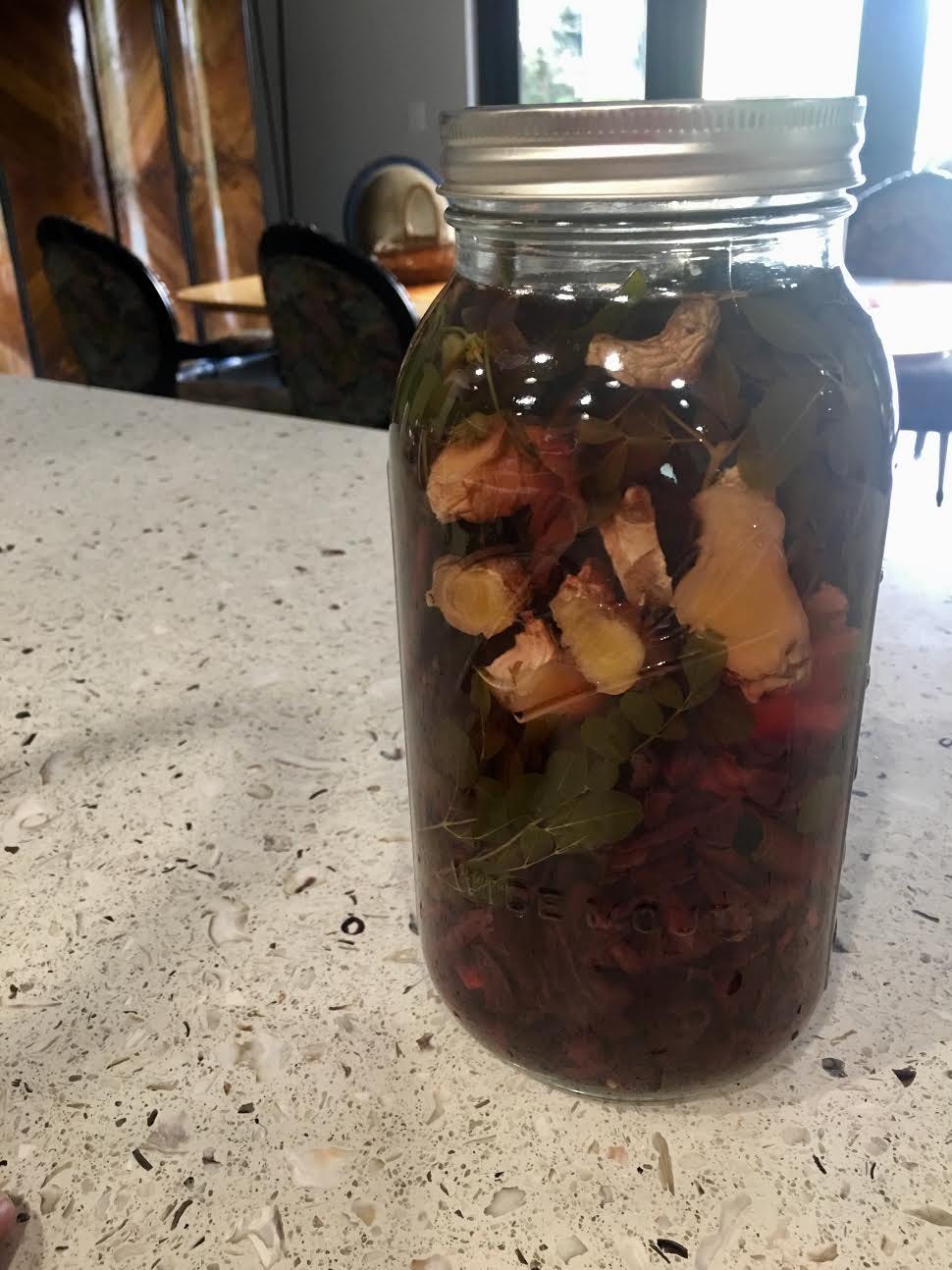
GUEST RECIPE
My name is Juliane Miklos and I’m an herbalist and gardener living in Boca Raton, Fla. I teach classes and make medicine out of the things I grow, forage, and get from local farmers/gardeners. I’ve converted a quarter-acre grass lawn into my own personal food forest and medicinal garden. Read about what I’m up to on my website: www.thegardenjules.com
Hey Hi & Welcome to Fall in Florida! Which I really think of as our spring, with all the seed sowing and flowers blooming. Unfortunately our “fall” is still hot as Hades. To cool down, I’ve been making the most refreshing beverage using plants growing in my yard.
One of my favorite ways to enjoy the bounty of what I grow is to make herbal infusions and decoctions.
Infusions are what you think of when you think of making tea. Boil water and pour it over the plant matter to infuse for 5-15 minutes. For decoctions, boil water with the plant material and let it simmer for 15-40 minutes. Generally, I infuse gentler plant matter like leaves and flowers and decoct more tough and fibrous plant matter like roots and barks.
There are some exceptions to the rules, like anything high in essential oils like ginger and lavender. Infuse those plants so as to not lose any of the precious oils in the steam. For fall, I’ve been making a delicious infusion from easy-to-grow and forage for in Florida plants. Plus, their beautiful colors really brighten a dinner party.
Happy Infusing,
Juliane
Ingredients
1 cup dried Hibiscus calyxes or 2 cups fresh harvested Hibiscus calyxes*
1/2 cup dried ginger or 1 cup fresh ginger
1 cup dried Spanish needle leaves, flowers, and stems or 2 cups fresh Spanish needle**
1 cup dried moringa leaves or 2 cups fresh moringa leaves
1 or 2 cinnamon sticks for an extra spicy touch (optional)
*Look for these cranberry-like flowers at farmers’ markets or ethnic groceries.
**Look for these edible weeds in the backyard.
Step-by-step
Use a 32 ounce glass jar to make the infusion. Mix all the plant material into the jar and let infuse for 15 minutes.
Add a little honey if desired, strain and enjoy. Or strain and put it in the fridge for a cooling beverage during these balmy fall days.
Juliane’s Instagrammable Zero Waste Toolkit
Check out this precious Zero Waste Toolkit that would be perfect for Sunshine + Microbes’ future glossy magazine. Give Juliane a follow on Instagram. Thanks again Farmer Mike for the inspiration!
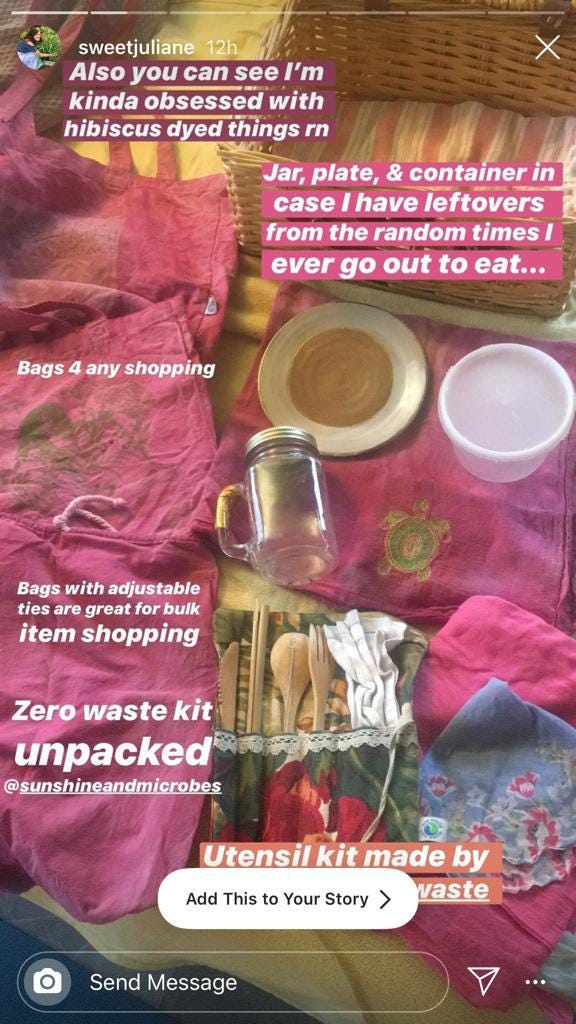
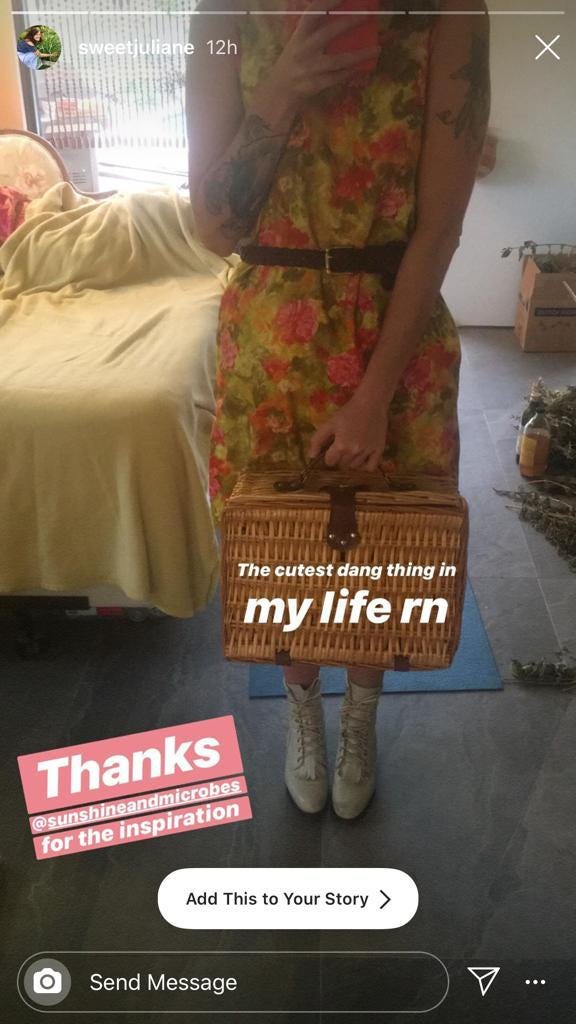

The National History Museum of London named their wildlife photos of the year last week. And while we feel bad for this marmot (🎶it’s the circle of life🎶), it’s also photogenic as heck. Click here to see the rest of the winners from Wildlife Photographer of the Year 2019.

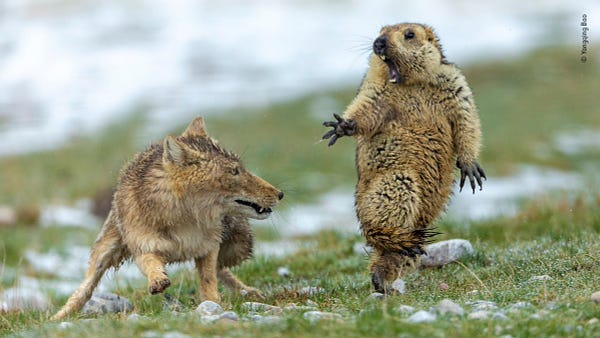
Talk to Us
Send in your comments, mailbag questions, recipe mishaps, or cooking tips: sunshineandmicrobes@gmail.com. Also do us a favor and follow us on Facebook and Instagram.
If you enjoyed this email, please share it with others. If someone forwarded this to you, click the button to sign up:
-------------------------------------------------------------------------------------------------
Sunshine + Microbes team
Jackie Vitale is the current Chef-in-Residence at the Robert Rauschenberg Foundation and co-founder of the Florida Ferment Fest. Her newsletter explores the intersection of food, culture, environment and community.
Matt Levin is a freelance reporter and English teacher based in Colombia. He edits Sunshine + Microbes and contributes other scraps to each issue.





